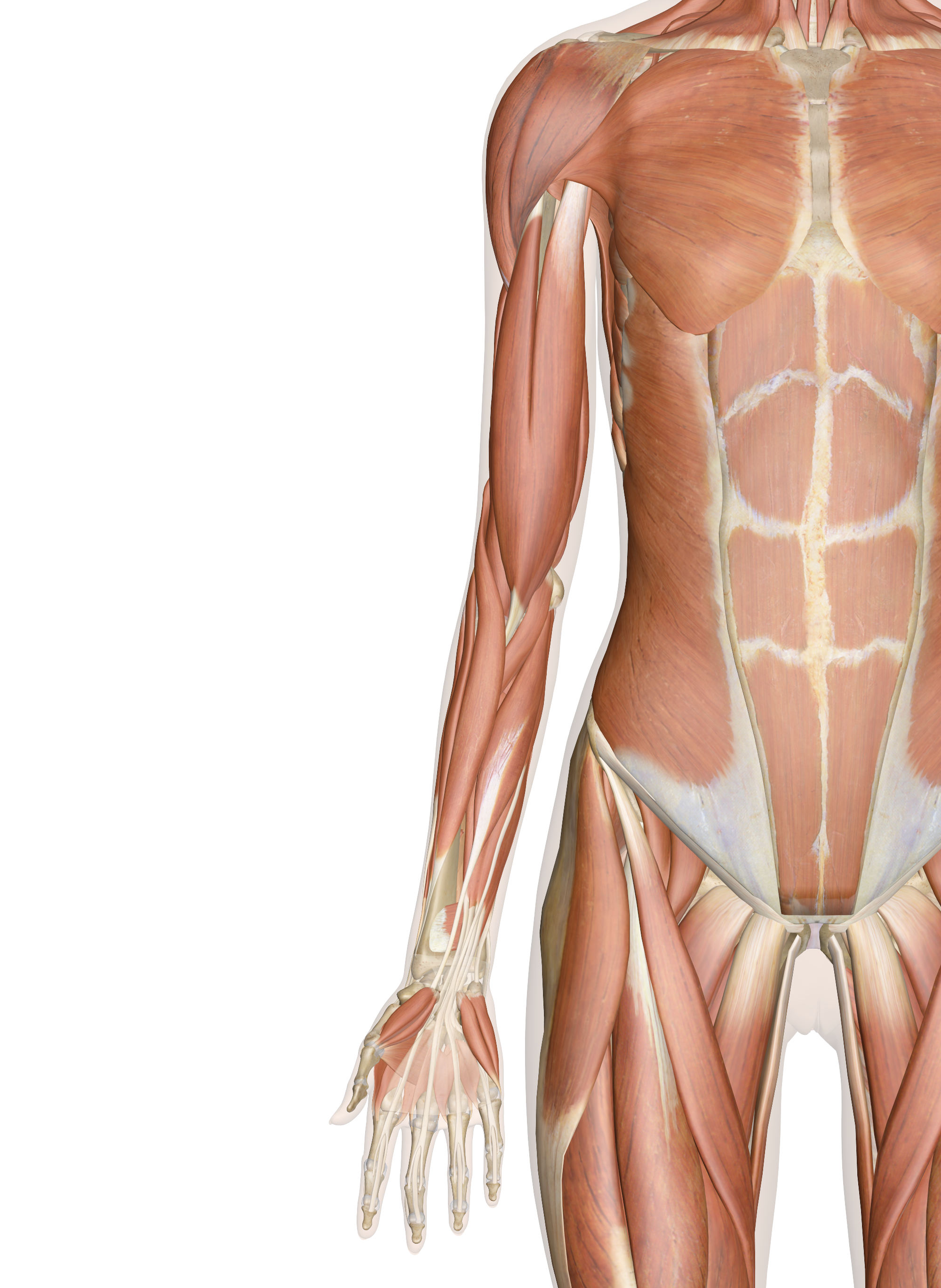The structure of our arms and legs is quite similar - one long bone forms the upper part of the limb and two smaller bones, arranged beside each other, form the lower part. The hands and feet are formed of many small bones.
Each of our arms consists of three long bones, the humerus in the upper arm and the radius and ulna in the lower arm. The radius is on the thumb side of the arm and the ulna on the little finger side. These three bones meet at the elbow joint, which is a simple hinge joint, enabling the opening and closing movements of extension and flexion. Just below the hinge of the elbow, the radius pivots on the ulna, allowing the supination (turning palm up) and pronation (turning palm down) of the forearm an palm. The ulna provides greater strength at the elbow joint, while the radius is the main weight bearing bone at the wrist joint. The radius and ulna meet with the eight wristbones, or carpals, forming a double hinge or ellipsoid joint. The palm of the hand is formed by five metacarpals, which articulate with the carpals at one end and the phalanges, or fingerbones, at the other. There are 14 phalanges, three in each finger, but only two in the thumbs. The many joints between these tiny bones, and especially the saddle joints at the base of each thumb, mean that the hands and wrists are capable of extremely delicate and fine movements.
The main muscles of the upper arm are the biceps brachii on the front of the humerus, which flexes the elbow, the opposing muscle on the back of the humerus, the triceps, which extends the elbow and thirdly, the deltoid, which starts at the collarbone (or clavicle) and shoulder blade and attaches halfway down the outside of the humerus - this helps lift the whole arm. In order to give the many joints of the hands and fingers their full range of movements, there are numerous muscles in the lower arm - too many to name individually. However, they can be divided into flexors, which bend the wrist joints and curl the fingers shut, and extensors, which stretch the wrists back an pull the fingers open.

There are also the pronators and supinators, which rotate the forearms, turning the palms up or down.
Our arms are suspended from the scapulas, or shoulder blades, and as these flat bones are attached to the skeleton only at the collarbone, they allow a great range of movement. The co-ordination and sophistication of movement in our hands and arms is truly amazing, possibly contributing to our success as a species. The larger muscles and joints of the upper arms contribute power and strength, whilst the smaller joints and muscles of the forearms, wrists and hands give us unmatched manual dexterity.
Stress and the Arms and Hands
One of the effects of stress and tension can be to affect our circulation. In our hands, this can lead to coldness and poor circulation, or it can worsen existing Raynaud's syndrome. Another very common effect of stress is muscular tension. This can affect the larger muscles of our upper arms, causing pain and stiffness.
It's very difficult to separate the functioning of the arm from that of the shoulder and neck, and tension in one can have a knock-on effect on the other, leading to a large area of discomfort and immobility. Upper arms muscle tension can also lead to nerve impingement, causing tingling or shooting pains down the arm.
Injury and Overuse
The joints of our arms can be susceptible to injury or overuse. Tennis or golfer's elbow are common terms and as their names suggest, these conditions are caused by overuse of the joint, especially if the surrounding muscles are tense.
The wrist is prone to damage through repeated use, especially during keyboard work. The term repetitive strain injury, or RSI, is used to cover a range of wrist, arm, shoulder and neck problems brought on by long-term overuse. So-called 'distinct' RSI includes definite conditions such as carpal tunnel syndrome (compression of the medial nerve as it passes through a tunnel-like band of tendon in the wrist), tendinitis (inflammation of the tendons), and others. 'Diffuse' RSI describes symptoms of generalised pain in the soft tissues of the forearm, due to nerve compression. It's often more difficult to obtain a definite diagnosis for this type of RSI. The symptoms of RSI, which become more severe if not treated, can include any or all of the following:
- tingling and numbness.
- pain and tenderness in the wrists, fingers, arms, neck and shoulders.
- muscle weakness or muscle spasms.
- swelling in the hands, wrists or forearms.
- inability to use the hands and arms for tasks such as writing, typing or carrying.
Symptoms will normally be mild at the outset, becoming more severe if not treated. The following factors can trigger RSI:
- Poor posture while working at a keyboard or badly designed/positioned work equipment.
- lack of movement or breaks whilst working at a desk/keyboard for long periods.
- so called 'double-use', e.g. knitting as a hobby after working at a keyboard all day.
- stress while working - feeling pressurised or trying to cope with heavy workloads.